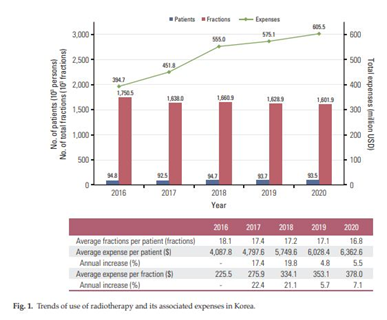글로벌 연구동향
방사선종양학
- [Cancer Res Treat .] Recent Trends of Medical Expenses Associated with Radiation Therapy in Korea Based on HIRA Big Data
성균관의대, 건강보험심사평가원 / 이정은, 양경미*, 허승재*
- 출처
- Cancer Res Treat .
- 등재일
- 2023 Jul
- 저널이슈번호
- 55(3):758-765. doi: 10.4143/crt.2022.389. Epub 2023 Jan 30.
- 내용
Abstract
Purpose: We aimed to determine the trends in the use of radiotherapy (RT) and the expenses associated with it in South Korea.Materials and methods: The statistical data of the claims and reimbursement records provided on the Health and Insurance Review and Assessment Service website were utilized. This included information such as the number of patients, fractions, medical expenses according to treatment codes, in/outpatient, sex, age, and regions of hospitals. We analyzed data from 2016 to 2020.
Results: With a growing RT infrastructure and an increase in the number of radiation oncologists, the expenses for RT were 605.5 million USD in 2020, which had increased 1.5 times from 394.7 million USD in 2016. This growth was mainly because of the increased usage of advanced RT techniques. Furthermore, the proportion of intensity-modulated radiation therapy (IMRT) expenses in the total expenses increased by 1.6 times from 48.8% in 2016 to 76.9% in 2020. Advanced techniques were used more commonly in older individuals or children. However, the proportion of IMRT expenses increased mostly in young women. Additionally, geographical differences in RT use and expense were observed, although the gap in the IMRT fractions decreased among the regions.
Conclusion: Recent medical expenses associated with RT in Korea have increased in tandem with technological advances and changes in demographics.

Affiliations
Jeong Eun Lee 1, Kyungmi Yang 2, Yong Chan Ahn 2, Won Park 2, Seung Jae Huh 3
1Department of Radiation Oncology, Kyungpook National University, School of Medicine, Daegu, Korea.
2Department of Radiation Oncology, Samsung Medical Center, Sungkyunkwan University School of Medicine, Seoul, Korea.
3Healthcare Review and Assessment Committee, Health Insurance Review and Assessment Service, Seoul, Korea.
- 키워드
- Health care costs; Intensity-modulated; Population dynamics; Radiotherapy.
- 덧글달기
- 이전글 [J Cancer Res Clin Oncol .] Novel scoring system guiding the incorporation of adjuvant RT for neuroendocrine neoplasms treated with surgical resection followed by chemotherapy
- 다음글 [Cancer Res Treat .] One-Week versus Two-Week Chemoradiotherapy Followed by Curative Surgery in Rectal Cancer: Long-Term Comparative Pooled Analysis of Two Prospective Multicenter Phase II Trials










편집위원
2016-2020년까지의 국내 방사선종양학과 현황 및 방사선치료 비용을 심평원 데이터 (HIRA big data based on NHIS) 분석을 통해 보고한 논문임. 전체 방사선치료비용은 2016년에 비해 2020년에 약 1.5배 상승했으며, 이는 방사선치료를 받는 환자의 수는 큰 변화 없고 치료 횟수(fractions)는 오히려 감소했으나 세기조절방사선치료(IMRT)의 보험적용 범위가 확대됨에 따른 실제 사용의 증가가 주요 원인으로 분석되었음. IMRT 비용의 증가는 30-40대 그룹에서 가장 많이 증가했는데, 유방암의 IMRT적용이 확대된 것을 그 이유로 분석했음. 향후 국내에서는 방사선치료 기술의 발전과 그 적용의 증가, 인구의 고령화에 따라 방사선치료 비용이 더 늘어날 것으로 예측함.
2023-09-06 11:02:52
편집위원2
건강보험심사평가원에서 제공되는 정보를 바탕으로 2016-2020년 사이의 방사선치료 관련한 의료비 지출을 분석함. 방사선치료 인프라 및 전문의의 증가로 2020년 방사선치료 관련한 비용은 USD 605.5 million이었으며, 이는 2016년 비용에 비해 1.5배 증가한 비용임. 이는 대개 진보된 방사선치료 기술의 사용의 증가로 기인하였음. 특히, 세기조절방사선치료 (IMRT) 비용이 차지하는 비율은 2020년 76.9%로 2016년에 비해 1.6배 증가함. 방사선치료 기술 발전과 임상적 사용의 증가, 고령 인구에서의 치료 확대 등에 따라 향후에도 방사선치료를 위한 의료비는 증가할 것으로 예상됨.
2023-09-06 11:07:37
편집위원3
이 논문은 최근 이슈가 되는 연구동향인 빅데이터 활용한 연구에 기준하여, 심평원의 대규모 데이터와 방사선 치료에 환자들이 소비하는 부분에 대한 것을 접목하여, 연구한 점에서 매우 흥미롭다고 생각함.
2023-09-06 14:25:28